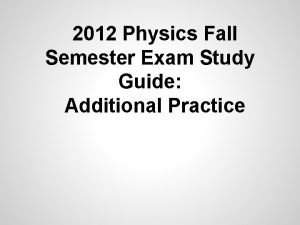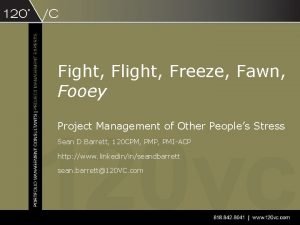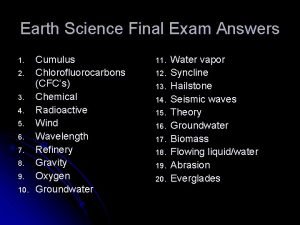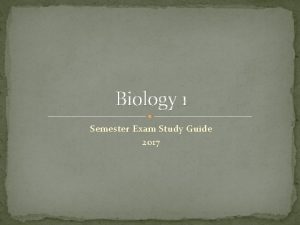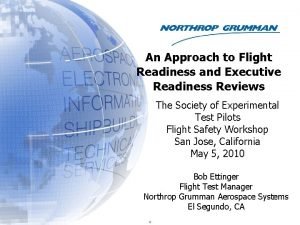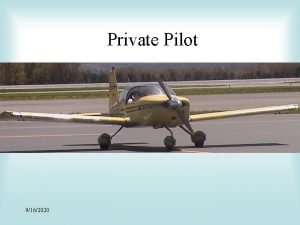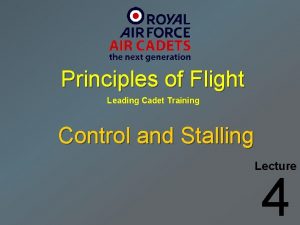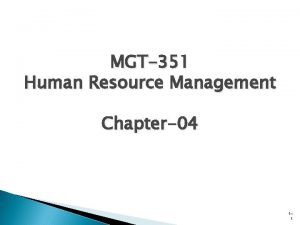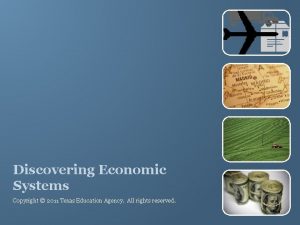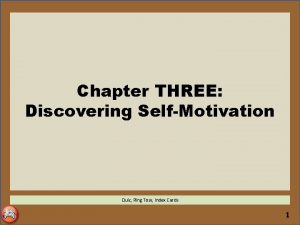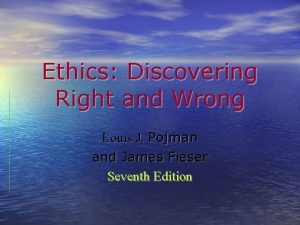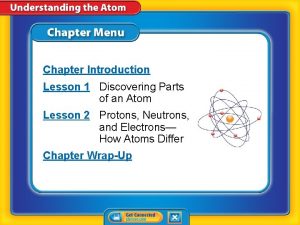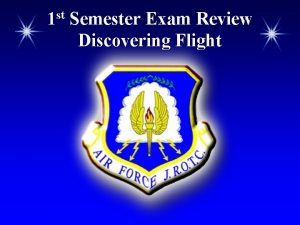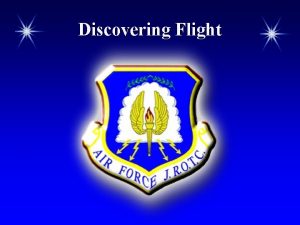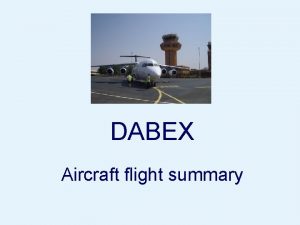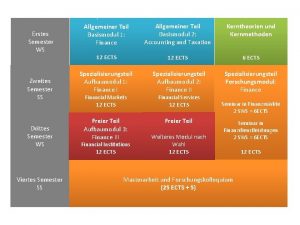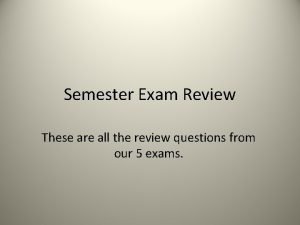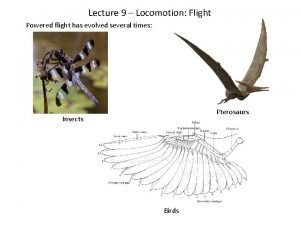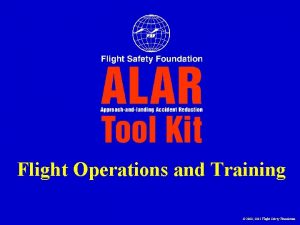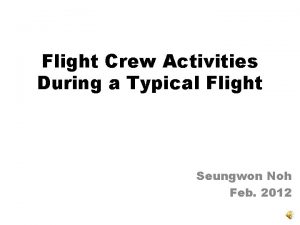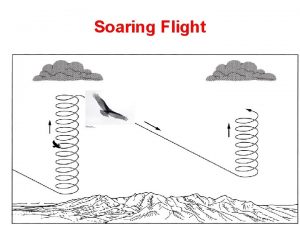1 st Semester Exam Review Discovering Flight EXAM





























































- Slides: 61

1 st Semester Exam Review Discovering Flight EXAM - December 11 th

Flight in Ancient Times Ø Humans have dreamed of taking flight for thousands of years Ø Flight is the act of passing through the air on wings Ø People told tales about flight around the fire at night and handed down these stories to their children Chapter 1, Lesson 1

Daedalus and Icarus Ø One of the best known is the Greek story of Daedalus and his son, Icarus Chapter 1, Lesson 1 Courtesy of the Granger Collection, New York

Armen Firman Ø A Moor named Armen Firman made the first known human attempt to fly Ø He put on a huge cloak and jumped from a tower in Cordoba, Spain Ø He hoped the cloak would open wide like a bat’s wings to slow him on the way down Ø But it didn’t, and Firman fell to his death Chapter 1, Lesson 1

Armen Firman Ø His unfortunate experiment might be described as an early attempt at a jump by parachute Ø A parachute is a device intended to slow free fall from an aircraft or another high point Chapter 1, Lesson 1

Key Aviation Devices From Ancient Times Chapter 1, Lesson 1 Courtesy of NASA

Chinese Kites Ø The Chinese invented the kite around 1000 BC Ø A kite is a light framework covered with paper or cloth, provided with a balancing tail, designed to be flown in the air Ø Within a few hundred years, people were using kites in warfare ! Chapter 1, Lesson 1 M o c r a lo o P

Chinese Gunpowder Ø In the eight hundreds, the Chinese made another important invention: gunpowder Ø Gunpowder is an explosive powder made of potassium nitrate, charcoal, and sulfur, used to shoot projectiles from guns Ø 200 years later, the Chinese used gunpowder to make the first simple rockets Chapter 1, Lesson 1

Man in the Moon Ø There’s even a Chinese legend about a rocket trip into space Ø A legend is an unverified story handed down from earlier times Wan Hoo

Leonardo da Vinci Ø The first person in the history of aviation who was also a real scientist was Leonardo da Vinci (1452– 1519) Chapter 1, Lesson 1

A Parachute and A Helicopter Ø Da Vinci produced the first known designs for a parachute and a helicopter Ø A helicopter is an aircraft that gets its lift from spinning blades Ø Da Vinci’s drawing of an “aerial screw” looks a lot like a modern helicopter Chapter 1, Lesson 1

Sir Isaac Newton Ø The Englishman Sir Isaac Newton (1643 -1727) formulated three famous laws of motion Chapter 1, Lesson 1 Taken from wikipedia. com

Newtonian Lift Ø The third law states, “For every action, there is an equal and opposite reaction” Ø For example, when a pilot angles the wing of the plane up against the oncoming wind, the action of the wind causes a reaction by the wing Ø This reaction provides some additional lift, known as Newtonian or dynamic lift Chapter 1, Lesson 1

Bernoulli Effect “Induced lift” Chapter 1, Lesson 1

The Early Days of Flight

Principles of Balloon Flight Ø A balloon operates on the principle of buoyancy Ø If the air or gas inside a balloon is lighter than the air around it, it will float Ø Hot air takes care of the first challenge of flight—getting up into the air Chapter 1, Lesson 2 Courtesy of Clipart. com.

Dirigibles Ø The third problem of flight—control of the craft—was still a problem Ø That is, until inventors came up with the dirigible Ø A dirigible is a steerable airship Chapter 1, Lesson 2

Dirigibles Ø The new dirigible airships had two things that helped pilots steer them Ø First, they had rudders Ø A rudder is a movable flap or blade attached to the rear of a craft Ø Second, the new airships had power sources that drove propellers Chapter 1, Lesson 2

Count von Zeppelin Ø In July 1900 Count von Zeppelin, a German inventor, built and flew the first successful rigid dirigible, the LZ-1 Ø This led to the world’s first commercial airships Ø The Zeppelins were luxurious: Ø Roomy, wood-paneled cabins Ø Carried 20 or more passengers Ø They flew at speeds exceeding 40 miles an hour Chapter 1, Lesson 2

Cayley’s Gliders Ø Cayley identified three important aviation forces: Ø Lift Ø Drag, which is the pull, or slowing effect, of air on an aircraft Ø Thrust, which is the forward force driving an aircraft Ø In 1850 Cayley built the first successful fullsize manned glider Chapter 1, Lesson 2

Otto Lilienthal Ø Otto Lilienthal of Germany is often called the “Father of Modern Aviation” Ø Between 1891 and 1896 he made more than 2, 000 glides Ø He also developed a powered biplane Ø A biplane is an aircraft with two main supporting surfaces, usually placed one above the other Chapter 1, Lesson 2

Samuel Langley Ø On 7 October 1903 his aircraft, the Aerodrome was ready for a test flight Ø The plane’s engine worked well, but the aircraft caught on the launching car on takeoff and fell into the river Ø Two months later, Langley tried—and failed —again Ø Government officials withdrew their support, so Langley gave up his project Chapter 1, Lesson 2

Samuel Langley Ø Historians fault Langley for spending too much time on how to power his aircraft, and not enough on how to control it Ø Even so, for his contributions to aviation, Langley Air Force Base in southeastern Virginia is named after him Chapter 1, Lesson 2

The Wright Brothers

How the Wright Brothers Succeeded in the First Flight Ø The Wrights chose a glider as their starting point Ø They could focus first on balancing and controlling the aircraft Ø Power (an engine) could come later Ø They applied what they learned at each step to make the next one go more smoothly Chapter 2, Lesson 1

Step One: Unmanned Box Kite Ø They discovered that they didn’t need to tilt an entire wing to turn the craft: Ø Needed to twist only the ends of the wings Ø They called this process “wing warping” Ø In the summer of 1899, Wilbur Wright successfully tested the kite in a field Chapter 2, Lesson 1

Step Two: Manned Gilders Ø Between 1900 and 1902, the brothers built three gliders Ø Before putting a man aboard, they flew each glider like a kite Ø They wanted to test it for control and lift Ø Only after doing this would they put a man aboard Chapter 2, Lesson 1

The First Glider (1900) Ø In their experiments in 1900, the Wrights placed an elevator at the front of the glider Ø Earlier designers mounted elevators behind the wings Ø But the Wrights found it easier to control climb and descent when the elevator was placed forward Chapter 2, Lesson 1

The Second Glider (1901) Ø The first glider didn’t have nearly enough lift Ø So for their 1901 glider, the brothers increased the wing area to 290 square feet Ø This glider was also a big disappointment Ø The brothers couldn’t control it well when they tested it at Kill Devil Hills Ø It flew less than 300 feet—time to return to Dayton! Chapter 2, Lesson 1

The Wind Tunnel Ø The brothers built a wind tunnel in their bicycle shop to test model-size wings Ø Made them of sheet steel Ø Cut more than 200 model wings of different shapes Chapter 2, Lesson 1 Courtesy of Wright State University

The Third Glider Ø The third glider had: Ø Forward elevator Ø Elliptical shape Ø Longer, skinnier wings Ø Wing area of 305 feet Ø Low angle of attack Ø This design was a success Ø The brothers took to the air in the North Carolina dunes more than 700 times in the fall of 1902 Chapter 2, Lesson 1 Courtesy of NASA

Principles of Airplane Flight Ø An engine and propellers gave Wilbur and Orville the ability to use not only lift but also thrust to propel their plane Ø Vertically mounted propellers could provide the airflow for thrust Ø They needed 90 pounds of thrust to propel the Wright Flyer Ø Their 12 -horsepower engine and the large propellers proved equal to the task Chapter 2, Lesson 1

Wright Brothers’ Involvement With the US Army Ø The British and French governments were interested in buying the Flyer Ø But the brothers wanted the US government to have the first crack at owning a Wright Flyer Ø On 22 May 1906 they received a government patent for their invention Chapter 2, Lesson 1

Bids for a Government Plane Ø On 23 December 1907, Gen James Allen sent out a request for bids to build a plane for the government Ø The Wright Flyer met the bid requirements Ø Orville Wright signed a contract on 10 February 1908 selling the Flyer to the US government Chapter 2, Lesson 1

Developing Aircraft

Ailerons Ø An aileron is a small flap on the wing for controlling turns Ø Ailerons replaced the Wright brothers’ wingwarping technique Ø The aileron was a more effective means to move an aircraft left or right Ø It also provided lateral balance Ø The association introduced ailerons to America but the idea originated in England Chapter 2, Lesson 2

Louis Blériot Ø French pilot Louis Blériot was the first man to cross the English Channel in a heavier-than-air craft Ø Although Blériot encountered problems —he got lost and his engine overheated —he managed to land safely Ø The flight took 37 minutes Chapter 2, Lesson 2

Bessie Coleman Ø Bessie Coleman faced two obstacles to becoming a pilot—her race and her gender; she overcame both Ø In 1921 Coleman became the first black woman to get a pilot’s license Ø She had to go to France for training because no flight school in the United States would accept her Ø She died in an airplane crash only four years after getting her license Chapter 2, Lesson 2

Air Power in World War I

Outbreak of WWI Ø Because of alliances among different nations in Europe, one country after another soon declared war The Allies The Central Powers Russia Germany France Serbia Britain Ø Soon the Allies were at war against the Central Powers http: //www. history. com/this-day-in-history/archduke-franz-ferdinand-assassinated Austria Hungary Turkey

The US Enters the War Ø US President Woodrow Wilson vowed that the United States would remain neutral Ø But over time, that proved impossible Ø German U-boats targeted all American ships headed toward Britain Ø Germany also made a secret deal with Mexico Ø The United States declared war on Germany and entered World War I in April 1917 Chapter 2, Lesson 3

The Lafayette Escadrille Ø Ø Ø Some American pilots didn’t wait for the United States to join the war The French Foreign Legion could sign up these volunteers In April 1916 seven American pilots formed a small fighting group called Escadrille Américaine They had to change the name to the Lafayette Escadrille By the time the United States Air Service brought the unit under its supervision in 1918, its pilots had made 199 kills https: //www. youtube. com/watch? v=Rcsdyy. Vs. X-4

Edward Rickenbacker Ø America’s ace of aces started out as a professional racecar driver Ø Col William (“Billy”) Mitchell helped Rickenbacker become a pilot Ø Rickenbacker rose from an enlisted Soldier to the rank of captain and took command of the 94 th Squadron https: //www. youtube. com/watch? v=9 Attk 7 t. Agt 8

Eugene Bullard Ø Bullard was the only African. American to serve as a pilot during World War I Ø Bullard signed up with the French Foreign Legion in October 1914 Ø He tried to join the US Air Service, but the Army turned him down Ø He shot down two German aircraft while in the French Air Service Chapter 2, Lesson 3

Stalemate Ø By 1917, the war in Europe was at a stalemate Ø A stalemate is a situation in which further action is blocked Ø A force was needed to tip the balance one way or the other Ø The Allies hoped that force would be the United States, which joined the effort in April Chapter 2, Lesson 3

The Role of Aircraft Ø Until WWI, most people thought the role of aircraft in combat was limited to aerial reconnaissance Ø Dropping bombs from the sky seemed an unlikely idea Ø Conducting battles between squadrons of planes also seemed far-fetched Chapter 2, Lesson 3

The Machine Gun Ø Another WWI innovation was the airplanemounted machine gun Ø French pilot Roland Garros was the first to bolt an automatic rifle to his plane Ø The Germans asked Dutchman Anthony Fokker to improve it—he built an interrupting gear Ø But soon the Allies and the Central Powers were again on equal footing Ø The famous dogfights commenced—a dogfight is a battle between fighter planes https: //www. youtube. com/watch? v=Sd 5 ub. G 3 HRi 8

The Battle of Saint Mihiel Ø September 1918: Air power played a tremendous role in this offensive Ø Billy Mitchell commanded nearly 1, 500 Allied airplanes Ø The Allied pilots had two goals: Ø To destroy German planes in the air Ø To destroy German aircraft in hangars on the ground Ø The Battle of Saint Mihiel helped lead to Allied victory two months later Chapter 2, Lesson 3

How the Airplane Revolutionized War Ø During WWI both sides sent up airplanes to shoot down observation aircraft Ø Each side had to protect its observation aircraft Ø Aerial combat was born Ø Once machine guns were mounted on planes, pilots could use them to strafe soldiers on the ground Ø To strafe is to attack with a machine gun from a low-flying aircraft Chapter 2, Lesson 3

Fighters Ø The fighter came into its own with the birth of the dogfight Ø These fighter aircraft needed three qualities: they had to be lightweight, fast, and maneuverable Ø By early 1918 fighters zipped along at a cool 130 mph Chapter 2, Lesson 3

Future of Aviation Ø Army staff officers still had their eyes focused on the infantry Ø They had no plans for their aviation section Ø But Brig Gen Billy Mitchell believed strongly in the future of aviation as an instrument in warfare https: //www. youtube. com/watch? v=Fv. AG 080 spwk Ø Today’s US Air Force still considers Mitchell one of its https: //www. youtube. com/watch? v=m. Ifuss_Ib. BY founding fathers Chapter 2, Lesson 3 Courtesy of the U. S. Air Force

The Barnstormers

The Barnstormers Ø A barnstormer is a pilot who travels around the country giving exhibits of stunt flying and parachuting Ø The term barnstorming comes from the time pilots would fly over a small rural town to attract attention, then land at a local farm https: //www. youtube. com/watch? v=FI 6 STwh. PCu. I

Stunt Flying Ø In the 1920 s the term became attached to stunt flying Ø Historians give stunt pilots like Bessie Coleman credit for sustaining the aviation industry during its early years https: //www. youtube. com/watch? v=wck. Ei. Kz. CBqc

End of War Ø On 14 November 1918, three days after the war ended, the US government canceled $100 million worth of airplane contracts Ø Within three months, 175, 000 workers in the aircraft industry lost their jobs Ø Aircraft production dropped by 85 percent Ø The Army dumped its surplus warplanes onto the market Chapter 3, Lesson 1

Former Army Pilots Ø Many of the barnstormers were former Army pilots Ø Since military aviation had been cut back, a large number lost their jobs Ø They leaped at the opportunity to keep flying Ø These pilots enjoyed showing off the skills they had mastered in combat Chapter 3, Lesson 1

Major Contributions of the Barnstormers Ø Historians call the years between 1919 and 1939 the “golden age of aviation” Ø Pilots set one record after another Ø They flew faster and attained greater altitude—the height above Earth’s altitude surface Ø They served as test pilots Chapter 3, Lesson 1

Richard E. Byrd Ø Trained as a flier, Rear Adm Richard E. Byrd advanced both aviation and polar exploration Richard E. Byrd

Barnstormers Contributed to Public Awareness of Aviation Ø The barnstormers’ demonstrations didn’t do away with people’s fears about flying Ø After all, spectators sometimes saw dreadful accidents Ø But the barnstormers’ air shows certainly created an interest in flight, even in rural areas and small towns Ø They publicized the airplane and brought romance to flying Chapter 3, Lesson 1

Know the Ranks of both the AFJROTC and active enlisted Air Force be able to organize them Chapter 1, Lesson 1

Chapter 1, Lesson 1
 World history 1st semester midterm exam review answers
World history 1st semester midterm exam review answers Us history semester 2 final exam review
Us history semester 2 final exam review Zoology semester 1 exam review answers
Zoology semester 1 exam review answers Physics fall semester review answers
Physics fall semester review answers Us history final exam semester 1
Us history final exam semester 1 English 3 fall semester exam review
English 3 fall semester exam review Ironydef
Ironydef Chemistry
Chemistry World history semester 1 final exam study guide answers
World history semester 1 final exam study guide answers Chemistry first semester exam review
Chemistry first semester exam review Sutterhe
Sutterhe Writ of certiorari ap gov example
Writ of certiorari ap gov example Chemistry semester 2 review unit 12 thermochemistry
Chemistry semester 2 review unit 12 thermochemistry Honors physics semester 1 review
Honors physics semester 1 review World history semester 2 final review packet
World history semester 2 final review packet Algebra 2 semester 2 final exam
Algebra 2 semester 2 final exam Geometry unit 5 review
Geometry unit 5 review Apes semester 1 final review
Apes semester 1 final review Biology semester 1 review 2018
Biology semester 1 review 2018 World history 1st semester final review answers
World history 1st semester final review answers English semester 2 final exam
English semester 2 final exam Pointing
Pointing Earth science semester 2 final exam answers
Earth science semester 2 final exam answers Spanish 1 answer key
Spanish 1 answer key Physics semester 1 final exam study guide answers
Physics semester 1 final exam study guide answers Biology grade 10 unit 3
Biology grade 10 unit 3 English 12 semester 1 exam
English 12 semester 1 exam Biology first semester exam study guide answers
Biology first semester exam study guide answers Accounting semester 1 exam
Accounting semester 1 exam Health unit 1 post test
Health unit 1 post test Personal eyeglasses provide as much protection as
Personal eyeglasses provide as much protection as English semester exam
English semester exam World history semester exam
World history semester exam Flight readiness review
Flight readiness review Private pilot limitations and privileges
Private pilot limitations and privileges Leading cadet principles of flight exam answers
Leading cadet principles of flight exam answers Participant diary/logs
Participant diary/logs Discovering the humanities 3rd edition
Discovering the humanities 3rd edition Discovering computers 2018 ppt download
Discovering computers 2018 ppt download Discovering computers 2016
Discovering computers 2016 Discovering computers
Discovering computers Self motivation define
Self motivation define Pure substances
Pure substances P value
P value Discovering economic systems comparative worksheet answers
Discovering economic systems comparative worksheet answers Discovering computers 2011
Discovering computers 2011 Dapps goal
Dapps goal Discovering computers 2018 chapter 1
Discovering computers 2018 chapter 1 Discovering science 7
Discovering science 7 Muhammed computer technology
Muhammed computer technology Discovering engineering
Discovering engineering Discovering american ideals in primary sources
Discovering american ideals in primary sources Teachers discovering computers
Teachers discovering computers Discovering science 7
Discovering science 7 Grade 8 science fluids
Grade 8 science fluids A r williams author of discovering tut
A r williams author of discovering tut Discovering personal genius
Discovering personal genius Tactile output device
Tactile output device Discovering computers 2012
Discovering computers 2012 Ethics discovering right and wrong
Ethics discovering right and wrong Chapter 7 lesson 1 discovering parts of an atom answer key
Chapter 7 lesson 1 discovering parts of an atom answer key Discovering the internet
Discovering the internet



